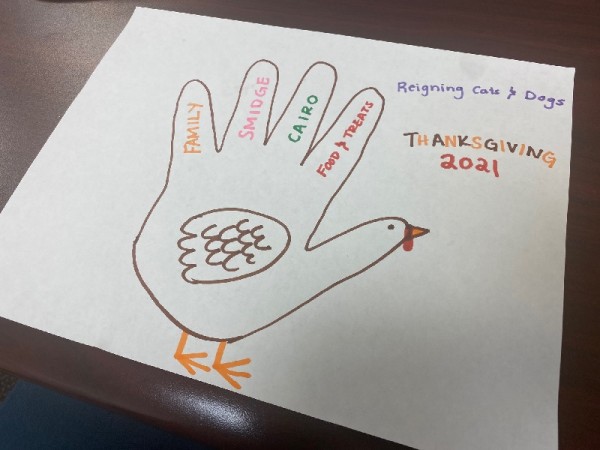Somehow, I didn’t ruin my rescue dog’s first trip to a sidewalk café even though I had to dislodge an entire scrambled egg from her throat.
Everything was surprisingly fine for my stranger-danger, resource-guarding rescue Chihuahua, Smidge, as we sat down at an outdoor café in a city she had never been to before, but I had made the mistake of ordering her a “Puppy Chow” bowl of unseasoned eggs, sausage and bacon bits instead of just a single piece of bacon to cut up and give her myself. Partially, I forget that she is essentially a Whopper with some French fries for legs and a tail, with bat ears attached to her paper ketchup cup head. And partially, I forgot the whole reason I hand feed her twice a day is because she moves through dog bowls like the inaugural sweep of a luxury vacuum and then gets a little too protective of whatever slobbered kibbles and bits are left, so it shouldn’t have surprised me that Smidge tore in to the Puppy Chow and I needed my mom’s help to take it away.
A few minutes later, she started coughing, then threw up a little. But then she kept coughing, and when her saliva became frothy, I took her away from the other tables and tried to soothe her so she could cough breakfast up. But she didn’t, and as seconds turned to minutes, the fur around her eyes became wet with tears and she panted heavily. Without thinking, I lifted her onto my thigh and gave two back blows, like you would to a choking an infant. One, two, and then a whole scrambled egg eased from her mouth onto the sidewalk.
That when my brain finally caught up. She’s choking… well, she was choking.
I had some specific knowledge – standard babysitting CPR certification in middle school, working with animals in the past - that led me to the first thing I did when my dog was choking: removing the puppy bowl contents stuck in her tiny throat by using whatever techniques I could remember. You can’t ask a dog if they are choking and expect a response, but I still am unhappy that I didn’t realize her distress earlier. That lingering emotion led me to the second thing I did after my dog almost choked: I looked for a first aid course for pets so I could learn proper techniques.
I reached out to a few local animal organizations and didn’t find a classroom course or certification in the area. I did find some information for professionals on the ASPCApro website, including a CPR video for spay/neuter clinics that shows us plebes the proper way to do chest compressions. The intensity of that content is interesting to watch and good information, but they aren’t for an average pet owner. I was referred to the Red Cross, along with the aforementioned ASPCA, and I decided to go for the Red Cross Cat & Dog First Aid online course. It’s roughly 35 minutes, $25 and covers a variety of topics, from checking vital signs to emergencies.
Since it’s online only, I was able to do the module at my desk, though I wish I had thought to bring a stuffed animal to practice the techniques and forms (like chest compressions) on. Luckily, I can log back in to the module even though I’ve completed it and review. Knowing that, I decided to take notes anyway – I’m definitely a better learner when I write things down.
Many of the methods you can use to save a furry life are similar to that of a human, minus some positioning. For example, you take a pulse on a dog or cat with the same multi-finger press, but on the inside of their back leg (don’t try that on an unsuspecting human) and for chest compressions, you lay the dog or cat on its side, instead of belly up. I also learned that my infant-esque back blows, while they worked and weren’t “wrong,” are actually best for larger dogs you can’t pick up, and smaller dogs and cats can withstand a more traditional Heimlich-style maneuver. There were also descriptions of signs and symptoms to check for that I had not thought about in my emergency situation.
The course also went over how to treat certain types of wounds, which were similar to people treatment, and it also taught me a lot about pet seizures. I have only seen one animal, a family friend’s dog, go in to a seizure. It happened so fast and not only did I not know what to do then, I still didn’t know before I took the course. I didn’t even know what a seizure really even looked like, let alone what to do if one of my pets had one, or that there were several reasons a pet could have one. More importantly I learned that the seizure doesn’t really end when it ends – some pets experience disorientation and temporary blindness – when to call a vet and that seizure medication can’t stop the episode completely.
For someone who took at least two, maybe three, human first aid courses and even got a little card for her teenaged wallet, placed with honor among crumpled dollar bills and gel pen ink stains, there was a lot I didn’t remember or didn’t know about pet first aid, even though much of it was similar to the human first aid I remembered learning. The caveat for me was this: even if I had remembered human first aid perfectly, had been re-certified and everything, I still wouldn’t have known just how to implement those techniques on a tiny Chihuahua.
Does this course supply you with an instructor and a nifty rubber dog with a fake heartbeat and pulse? No. Does it offer detailed information on how to manipulate skills you may already know on a smaller, furrier level? Yes. Does it offer helpful basic information you may not have known beforehand, or forgot? Also yes. If you want something more intense, you may not find it online, but you could use the ASPCA videos I mentioned before to see how the professionals handle situations like this. If you’re already some kind of animal medical volunteer, this course is probably information you already know very well, and if you’re current on human first aid and CPR, this may seem repetitive, since many of the maneuvers are similar.
Also, don’t hesitate to actually try the moves on a stuffed animal. Not only are stuffed animals more accessible than a robot German Shepard covered in rubber skin, the Red Cross instructs not to test the methods on a healthy animal. And really, can you imagine your pet sitting still for .5 seconds so you could test out even one of the more benign moves!?
After I printed my nifty certificate that says I completed the course, I thought about my dog. She tried so hard to dislodge the egg herself, because in her old life, I don’t think anyone would have been there to really help her. She didn’t want to give up precious food and when the egg landed in the gutter, I had to pull her away from it. It hit me right in the heart that she refused to cry out for help, that she had been in a situation where if she threw up her food she knew she wouldn’t get any more, that she felt like she had to protect and guard that food even though it was causing her pain. Was it because every dog around her was suffering too, and they didn’t care if the food was rancid now? I’ll never know for sure. But as I sat in the café with my precious rescue on my lap, my mother fed her the rest of her bacon bits and we made sure she had plenty of water. It amazed me how quickly and simply she bounced back from the face of danger. Smidge never flinched while I transferred bites of crepe over her head with my fork. She didn’t get snarky with any of the other dogs there, even the big ones that sat down right next to her and normally would have sent her into a tizzy. No barking and no growling.
As I walked her – not carried, walked – away from the café, yellow bandana bobbing in the coastal breeze, she was smiling. In this encompassing moment, after the egg, from the metal table and chairs to the cobblestone sidewalk, she was able to lavish in the thought that she, for once, was a regular dog, a no-strings-attached, no-emotional-baggage, no-hard-knocks, not-choking-on-scrambled-eggs dog.
It was warm, approaching noon. She looked up at me, tongue out, as the people walked by us. I picked her up and spent the rest of the walk through town whispering sweet nothings into those big ol’ ears. There are several acronyms in first aid, and while this one isn’t in the module, I’ve found it can be very helpful, especially when your pet is stressed. Or at any time, it’s kind of pet health maintenance. When in doubt, when you don’t know how to help the situation, if it’s just been a while, remember TAIL: Tell Animal It’s Loved.

















